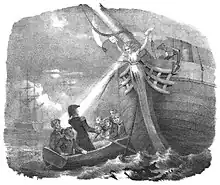
The Water-Witch is an 1830 novel by James Fenimore Cooper. Set in 17th-century New York and the surrounding sea, the novel depicts the abduction of a woman, Alida de Barbérie, by the pirate captain of the brigantine Water-Witch, and the subsequent pursuit of that elusive ship by her suitor, Captain Ludlow.[1][2]
Cooper wrote the novel while on an extended tour of Europe, during his stay in the villa Palazzu detta del Tasso near Naples.[1] Cooper tried to print the novel while he was in Italy in 1829 but Papal censors forbade its publication there.[1] He was eventually able to print the novel in Dresden before also sending copies to his publishers in the US and England.[1] Critic Allan Axelrod describes the novel as heavily influenced by the Italian context of its writing, noting that it even compares the landscapes of New York with that of Italy.[3]
The unincorporated community of Waterwitch, New Jersey is named after the novel.[4]
References
- 1 2 3 4 Baym, Max I.; Matenko, Percy (January 1970). "The Odyssey of The Water-Witch and a Susan Fenimore Cooper Letter". New York History. LI (1): 33–41 – via James Fenimore Cooper Society.

- ↑ "The Great Snow Storm: Extract for a Letter from William E. Waples, Esq". The Register of Pennsylvania. Vol. 7, no. 16. April 16, 1831. p. 246. ProQuest 91284032.
- ↑ Axelrad, Allan M. (July 1993). James D. Wallace (ed.). Epiphany at Ischia: The Effect of Italy on James Fenimore Cooper's Literary Landscape Painting. 9th Cooper Seminar, James Fenimore Cooper: His Country and His Art. State University of New York College at Oneonta. pp. 1–27.
- ↑ Paul T. Hellmann (14 February 2006). Historical Gazetteer of the United States. Routledge. p. 722. ISBN 1-135-94859-3.
Further reading
- Lampe, David (July 2013). Steven Harthorn (ed.). Double Dutch Delights: Irving's Knickerbocker History and Cooper's Water Witch. 19th Cooper Seminar, James Fenimore Cooper: His Country and His Art. State University of New York College at Oneonta. pp. 18–24.
External links
- The Water-Witch at Project Gutenberg
- Scans and transcription of the Original Dresden printing of the novel